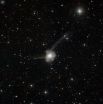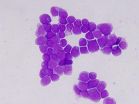(Press-News.org) Atoms-for-Peace is the curious name given to a pair of interacting and merging galaxies that lie around 220 million light-years away in the constellation of Aquarius. It is also known as NGC 7252 and Arp 226 and is just bright enough to be seen by amateur astronomers as a very faint small fuzzy blob. This very deep image was produced by ESO's Wide Field Imager on the MPG/ESO 2.2-metre telescope at ESO's La Silla Observatory in Chile.
A galaxy collision is one of the most important processes influencing how our Universe evolves, and studying them reveals important clues about galactic ancestry. Luckily, such collisions are long drawn-out events that last hundreds of millions of years, giving astronomers plenty of time to observe them.
This picture of Atoms-for-Peace represents a snapshot of its collision, with the chaos in full flow, set against a rich backdrop of distant galaxies. The results of the intricate interplay of gravitational interactions can be seen in the shapes of the tails made from streams of stars, gas and dust. The image also shows the incredible shells that formed as gas and stars were ripped out of the colliding galaxies and wrapped around their joint core. While much material was ejected into space, other regions were compressed, sparking bursts of star formation. The result was the formation of hundreds of very young star clusters, around 50 to 500 million years old, which are speculated to be the progenitors of globular clusters.
Atoms-for-Peace may be a harbinger of our own galaxy's fate. Astronomers predict that in three or four billion years the Milky Way and the Andromeda Galaxy will collide, much as has happened with Atoms-for-Peace. But don't panic: the distance between stars within a galaxy is vast, so it is unlikely that our Sun will end up in a head-on collision with another star during the merger.
The object's curious nickname has an interesting history. In December 1953, President Eisenhower gave a speech that was dubbed Atoms for Peace. The theme was promoting nuclear power for peaceful purposes — a particularly hot topic at the time. This speech and the associated conference made waves in the scientific community and beyond to such an extent that NGC 7252 was named the Atoms-for-Peace galaxy. In many ways, this is oddly appropriate: the curious shape that we can see is the result of two galaxies merging to produce something new and grand, a little like what occurs in nuclear fusion. Furthermore, the giant loops resemble a textbook diagram of electrons orbiting an atomic nucleus.
INFORMATION:
More information
ESO, the European Southern Observatory, is the foremost intergovernmental astronomy organisation in Europe and the world's most productive astronomical observatory. It is supported by 14 countries: Austria, Belgium, the Czech Republic, Denmark, France, Finland, Germany, Italy, the Netherlands, Portugal, Spain, Sweden, Switzerland and the United Kingdom. ESO carries out an ambitious programme focused on the design, construction and operation of powerful ground-based observing facilities enabling astronomers to make important scientific discoveries. ESO also plays a leading role in promoting and organising cooperation in astronomical research. ESO operates three unique world-class observing sites in Chile: La Silla, Paranal and Chajnantor. At Paranal, ESO operates the Very Large Telescope, the world's most advanced visible-light astronomical observatory and VISTA, the world's largest survey telescope. ESO is the European partner of a revolutionary astronomical telescope ALMA, the largest astronomical project in existence. ESO is currently planning a 42-metre European Extremely Large optical/near-infrared Telescope, the E-ELT, which will become "the world's biggest eye on the sky".
Contacts
Richard Hook
ESO, La Silla, Paranal, E-ELT and Survey Telescopes Public Information Officer
Garching bei München, Germnay
Tel: +49 89 3200 6655
Cell: +49 151 1537 3591
Email: rhook@eso.org
Atoms-for-Peace: A galactic collision in action
2010-11-11
ELSE PRESS RELEASES FROM THIS DATE:
Scientists launch global scheme to boost rice yields while reducing damage to environment
2010-11-11
Hanoi, Vietnam (November 10, 2010)—One of the world's largest global scientific partnerships for sustainable agricultural development has launched a bold new research initiative that aims to dramatically improve the ability of rice farmers to feed growing populations in some of the world's poorest nations. The efforts of the Global Rice Science Partnership, or GRiSP, are expected to lift 150 million people out of poverty by 2035 and prevent the emission of greenhouse gases by an amount equivalent to more than 1 billion tons of carbon dioxide.
An initiative of the Consultative ...
Romiplostim more effective than standard care for immune thrombocytopenia
2010-11-11
A new study finds that an FDA-approved drug to treat the rare autoimmune disorder immune thromobocytopenia (ITP) is more effective than earlier medical therapies in helping patients avoid surgical treatment and significantly improving their quality of life. The paper in the Nov. 11 New England Journal of Medicine reports that treatment with romiplostim, which mimics the effects of a growth factor that regulates platelet production, was more than three times more successful than standard therapy with steroids or immunosuppressive drugs.
"This is the first definitive ...
Inhibitory neurons key to understanding neuropsychiatric disorders
2010-11-11
HOUSTON -- (Nov. 11, 2010) – The brain works because 100 billion of its special nerve cells called neurons regulate trillions of connections that carry and process information. The behavior of each neuron is precisely determined by the proper function of many genes.
In 1999, Baylor College of Medicine (www.bcm.edu) researcher Dr. Huda Zoghbi (http://www.bcm.edu/genetics/index.cfm?pmid=11053), and her colleagues identified mutations in one of these genes called MECP2 as the culprit in a devastating neurological disorder called Rett syndrome (http://www.nichd.nih.gov/health/topics/rett_syndrome.cfm). ...
Stem cell transplants in mice produce lifelong enhancement of muscle mass
2010-11-11
A University of Colorado at Boulder-led study shows that specific types of stem cells transplanted into the leg muscles of mice prevented the loss of muscle function and mass that normally occurs with aging, a finding with potential uses in treating humans with chronic, degenerative muscle diseases.
The experiments showed that when young host mice with limb muscle injuries were injected with muscle stem cells from young donor mice, the cells not only repaired the injury within days, they caused the treated muscle to double in mass and sustain itself through the lifetime ...
Tetris flashback reduction effect 'not common to all games'
2010-11-11
The computer game Tetris may have a special ability to reduce flashbacks after viewing traumatic images not shared by other types of computer game, Oxford University scientists have discovered in a series of experiments.
In earlier laboratory work the Oxford team showed that playing Tetris after traumatic events could reduce memory flashbacks in healthy volunteers. These are a laboratory model of the types of intrusive memories associated with post-traumatic stress disorder (PTSD).
In this new experimental study, the researchers compared the effectiveness of Tetris ...
Colorectal cancer risk increases in prostate cancer patients on androgen deprivation therapy
2010-11-11
Men taking androgen deprivation therapy (ADT) for prostate cancer may have an increased risk of colorectal cancer, according to a study published online November 10 in The Journal of the National Cancer Institute.
Androgen deprivation therapy is a widely-prescribed treatment in men with prostate cancer, although its usage for low-risk disease remains controversial, given the adverse side effects, including osteoporosis, cardiovascular disease, diabetes and obesity; the last two are risk factors for colorectal cancer.
To determine whether prostate cancer patients taking ...
Why New York City is average: Researchers want to improve how we determine urban exceptionality?
2010-11-11
Think New York is an exceptional city? It's not. The Big Apple is just about average for a city of its size. However, San Francisco is exceptional. Its inhabitants are wealthier, more productive, more innovative, and subject to fewer crimes than you would expect, given its size.
Turns out many of the cities we typically think of as great ones probably wouldn't show up near the top of most rankings, if Luis Bettencourt of the Santa Fe Institute has his way. He and his colleagues believe traditional per-capita measures are not very useful for determining what makes one ...
Don't clamp umbilical cords straight after birth, urges expert
2010-11-11
Obstetricians and midwives should wait a few minutes before clamping the umbilical cords of newborn infants so that babies are not harmed by the procedure, argues Dr David Hutchon in an article published on bmj.com today.
Hutchon, a retired consultant obstetrician from the Memorial Hospital in Darlington, says it's time for the UK to follow guidance from the World Health Organisation and the International Federation of Gynaecology and Obstetrics and refrain from early cord clamping.
Despite evidence for the benefit of delayed cord clamping, clinicians in the UK seem ...
Mutations in single gene predict poor outcomes in adult leukemia
2010-11-11
AUDIO:
Researchers at Washington University in St. Louis have identified mutations in a single gene that are associated with a poor prognosis for patients with acute myeloid leukemia. The discovery suggests...
Click here for more information.
Decoding the DNA of a woman who died of acute myeloid leukemia (AML) has led researchers at Washington University School of Medicine in St. Louis to a gene that they found to be commonly altered in many patients who died quickly of ...
Researchers discover key mutation in acute myeloid leukemia
2010-11-11
Researchers have discovered mutations in a particular gene that affects the treatment prognosis for some patients with acute myeloid leukemia (AML), an aggressive blood cancer that kills 9,000 Americans annually. The scientists report their results in the Nov. 11, 2010, on-line issue of The New England Journal of Medicine.
The Washington University School of Medicine in St. Louis team initially discovered a mutation by completely sequencing the genome of a single AML patient. They then used targeted DNA sequencing on nearly 300 additional AML patient samples to confirm ...

